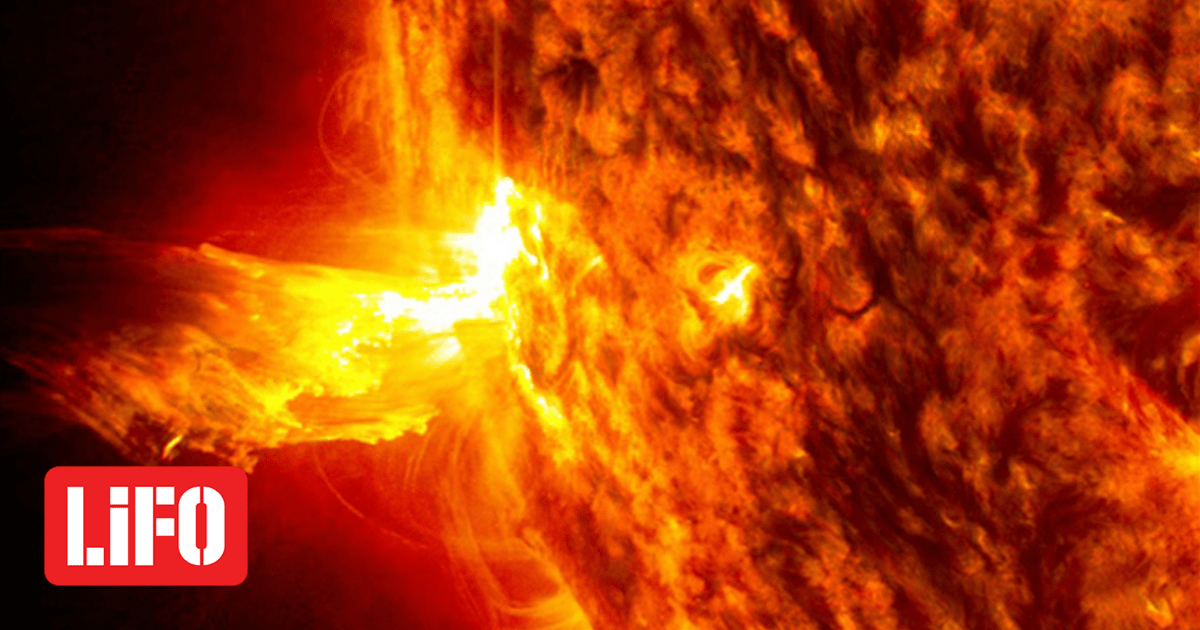
We know what it is Space weather? Can solar storms affect our planet? When does the sun get angry and why?
doctor. Olga Malandrakia Greek researcher in space physics, an expert in space weather, and head of the operational space weather unit of the National Observatory of Athens (EAA), which provides unique international level forecasts of space weather, spoke to LiFO on this occasion. Her latest award from NASA He referred, among other things, to the secrets of the sun.
Olga Malandracki recently received a Team Achievement Award from NASA for her research into the mysteries of the Sun. The NASA Group Achievement Award is an award given to groups of government or non-government employees in recognition of group achievements that contribute to NASA’s mission.
“The award from NASA is in recognition of unexpected discoveries near the Sun and the high level of scientific analysis of data received from the spacecraft.” parker solar probe, Which for the first time in human history “literally “touches” the sun,” he noted at the beginning.
Our Sun is a star that gets angry and cools down every 11 years or so. Powerful storms such as solar flares occur. Billions of tons of hot material are also being launched into space, and when they head towards our Earth, they collide with our magnetic field, shaking it, disrupting it and causing a geomagnetic storm.
It also emphasizes synergy with ESA’s sister Solar Orbiter mission, which has a similar scientific goal. “The Parker Solar Probe is constantly working on a ring-like orbit around the Sun. Every time it does another one, the ring gets closer and so Parker, without colliding with the Sun, will reach a distance equal to 9 radii from our star, which is its closest perihelion. We are towards that Perigee nineteen “And there will be a lot more to come, so analyzing this new data is an ongoing challenge and a bet, if you will, for the foreseeable future.”
NASA’s Parker Solar Probe touches the Sun for the first time
What is space weather forecasting?
Then Olga Malandraki analyzes what the prediction is for those who have not delved into the mysteries of space Space climate.
“Hey sun Our star gets angry and calms down from time to time 11 years. Powerful storms such as solar flares occur. “Billions of tons of hot material are also launched into space, and when they head toward our Earth, they collide with our magnetic field, shake it, disrupt it, and cause a geomagnetic storm,” the researcher says.
Specifically for frequency Solar storms He reiterates that based on experience from analysis of solar data “our Sun has an eleven-year activity cycle ranging from major explosive activity to minor explosive activity.” However, he explains, “We don’t know exactly how often solar storms occur.”
As he explains, energy particles are released, which can also work With the speed of light and “all these explosive phenomena.” “It has the effect of creating adverse conditions in space that can cause problems.”
Specifically, these phenomena can, as Olga Malandracci stated,:
• To influence wireless communications,
• Causing disruption to the operation of satellites.
• Creating problems in aircraft navigation,
• Causing damage to electrical power units,
• It would be fatal to astronaut crews on the Moon and Mars.
doctor. Olga Malandraki. Photo: Facebook
“That’s where solar storms come from It is not fatal For us humans on this planet we are protected by the shield of our Earth’s magnetic field, but it can lead to a variety of… Losses and social and economic impacts He points out that our society relies too much on technology.
One way to deal with all this is Diagnosis Of these explosive solar storms And its effects, which include space weather forecasting. “At the Athens Observatory, I am pleased to be the head of HESPERIA’s Space Weather operations unit, which provides globally unique forecasts and space weather products, all over the world,” he emphasizes.
“Protons can reach an altitude similar to that of an airplane.”
Then d. Olga Malandraki She analyzes the tools used in her team’s work and how they work.
“We are not ‘night’ astronomers making observations with telescopes. The data we analyze are mainly in situ measurements within the solar system by spacecraft. What is new is that the spacecraft goes there carrying a complete laboratory and records.” Clusters of energetic particlesPlasma, magnetic field, etc. “Parker also came close to the Sun and we got data from there,” he told LiFO.
He also says: “We have created forecasting tools Space climatewhich produces a minute-by-minute, real-time forecast of potential hail Of protons “It can reach space in Earth’s orbit, but also for very fast protons that can partially penetrate the magnetic field and reach the height of aircraft.”
How much does humanity know about the Sun and what can it hide from us?
“Since about the beginning of the Space Age in the 1960s, with spacecraft carrying camera experiments and taking in situ measurements, we have largely understood the Sun and its activity,” says Dr. Malandraki.
He points to the Ulysses mission, which explored the region above the sun’s poles and drew a three-dimensional map of the heliosphere for the first time, from 1993 to 2009.
The Legacy of Ulysses: Observing the Sun for 17 Years
“However, there are still unsolved mysteries such as The warming paradox As we move outward from the surface of the Sun. With innovative spaceships Parker Solar Probe And Solar orbit Which provides for the first time measurements very close to the Sun, we expect to map the Sun, its physical processes and solar storms more accurately than before, as we see the phenomena at their origin, without distortions due to the great distance until they propagate to the Earth,” he says.
The National Observatory and transferred it to the Ministry of Climate Crises
At the end of our conversation, Dr. Olga Malandraki “lands” in Greek reality. On the occasion of the mobilization of workers’ associations and researchers at the National Observatory regarding the government initiative to transfer supervision of the National Observatory to the Ministry of Climate Crisis and Civil Protection, it is stated:
“The National Observatory in Athens is a cradle of research in many thematic areas, such as astronomy, space physics, cosmology, meteorology, seismology, etc. It is therefore absolutely essential to ensure the continuity of the high-level research work we are doing Observatory. I consider the initiatives taken to secure the research project, i.e. the validity of the scientific research law and its relevance to the subject GEK, General Secretariat for Research and Innovation“As a reference for the research project, it is in the right direction.”

“Total alcohol fanatic. Coffee junkie. Amateur twitter evangelist. Wannabe zombie enthusiast.”




More Stories
Find out what the iPhone 16 will look like – “fake” images of all models
A little girl went on vacation and almost lost her life: the symptoms she ignored and meningococcal disease
Silent Hill 2: Bloober Team 'Very Confident' About Finale